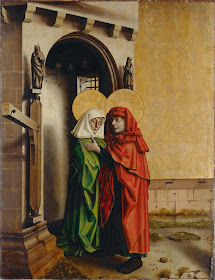 |
| Ambrosius Benson, 1530 |
In spite of his common popularity throughout the ages of Christendom, St. Joachim did not receive a general feast in the Roman Rite until the 1500s, when it was assigned to March 20 by P. Julius II. Previously it had been celebrated in various places on September 16 and December 9. In 1793, the feast was moved to the Sunday after the Assumption by P. Clement XII, then to August 16 by P. Pius X. Under the 1969 kalendar overhaul, Joachim's feast was merged with Anne's for a unified July 26 feast (the day of her dormition), but Catholics celebrating the Old Latin Mass will be venerating the grandfather of God today.
The name and story of Joachim are known to us primarily through the Proto-Gospel of James, a work much despised by hagiographical iconoclasts, and by St. Jerome. Some biblical commentators have discerned a mention of Joachim in the Heli of St. Luke's Gospel (via the variant Eliachim), although this is far from certain. His name is shared with the wicked Jehoiakim (Joakim), one of the last kings of Judah before the Babylonian captivity.
 |
| Albrecht Dürer, 1504 |
Joachim and Anne's house in Jerusalem was converted into a church known as St. Anne's or the Holy Probatica, probably by St. Helena. In the ninth century it was converted into an Islamic school, but the crypt below was permitted to remain as a pilgrimage site by the Muslims. Pilgrims were forced to slide down a small chute in order to visit the crypt.
From the readings of Mattins, a selection from the sermon of St. Epiphanius:
These three, Joachim, Anne, and Mary, clearly offered up unto the Trinity a sacrifice of praise. For the name Joachim being interpreted, signifieth "the preparation of the Lord", and out of him was prepared the Temple of the Lord, namely, the Virgin. The name Anne signifieth grace, and she and Joachim did indeed receive a grace when, in answer to their prayers, they generated such an offspring, compassing the Holy Virgin. Joachim prayed upon the mountain and Anne in her garden.
 |
| Konrad Witz, 1435 |
No comments:
Post a Comment